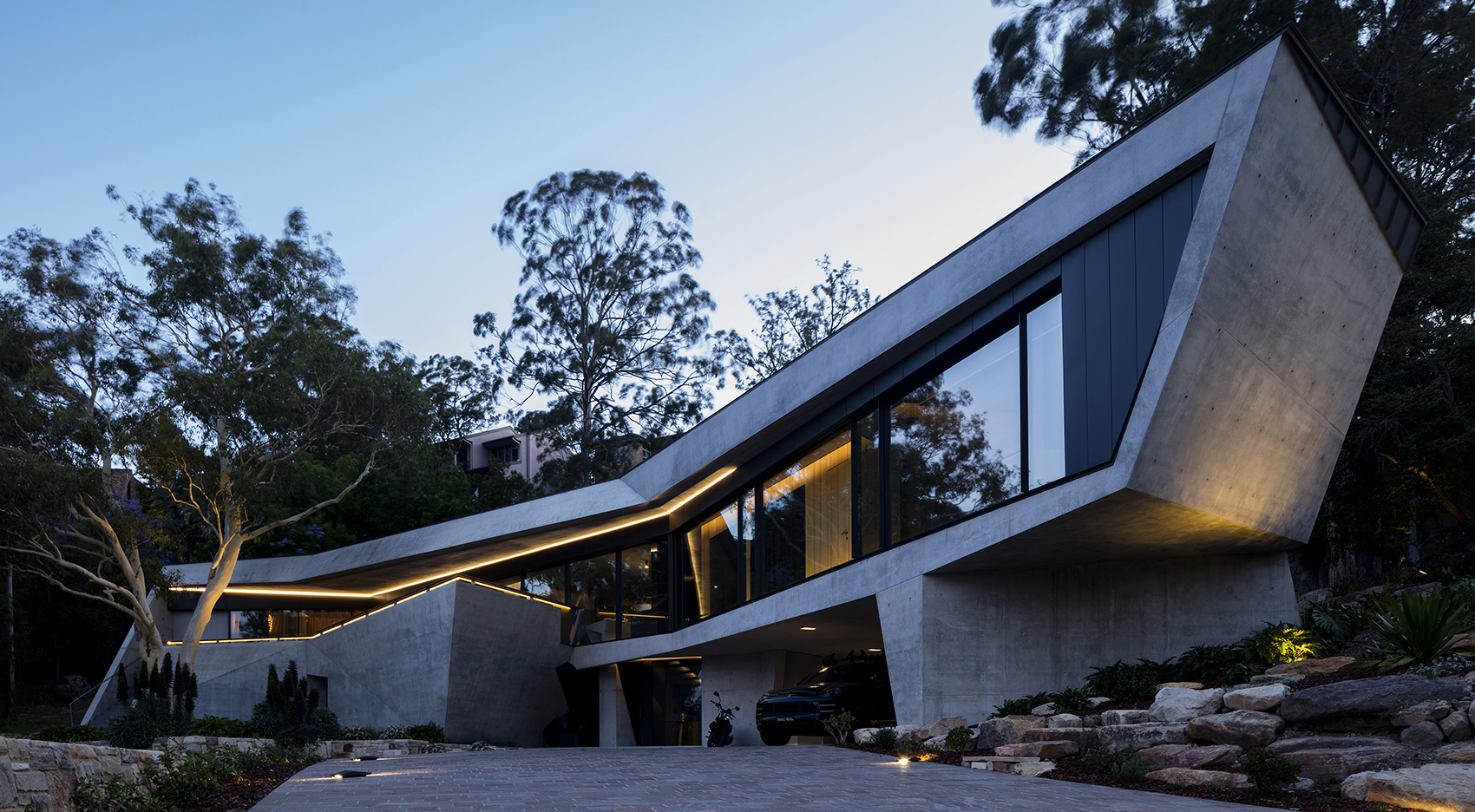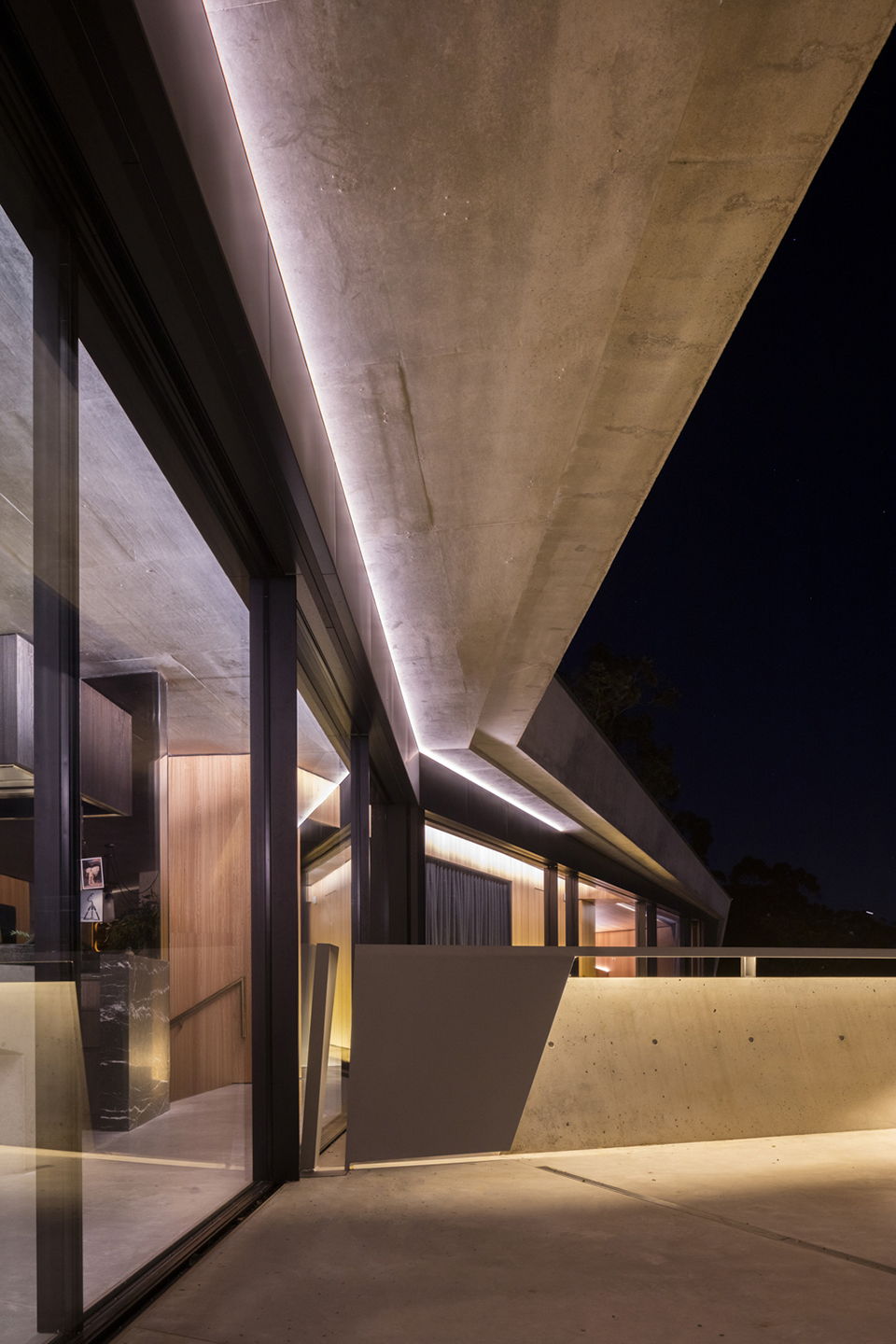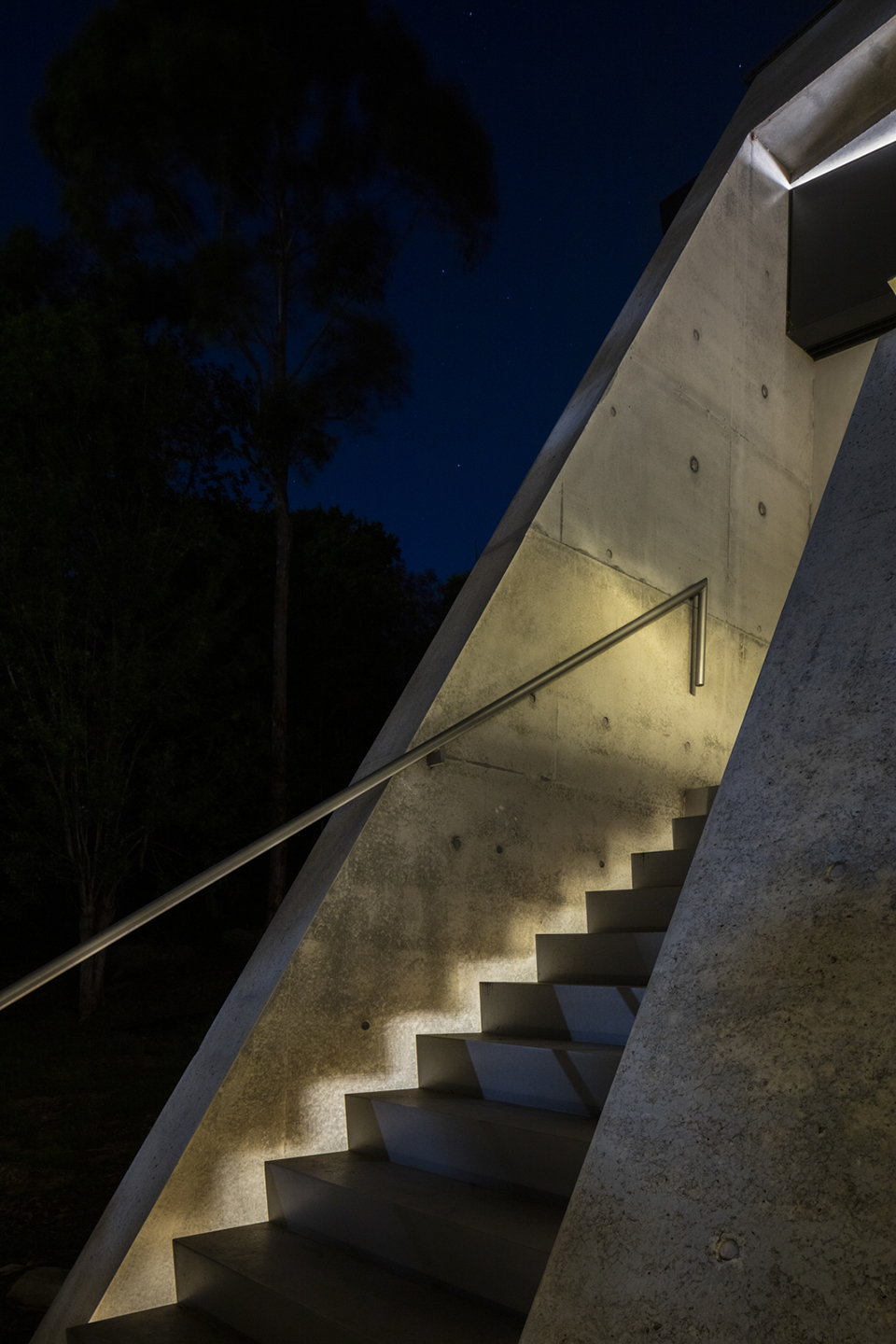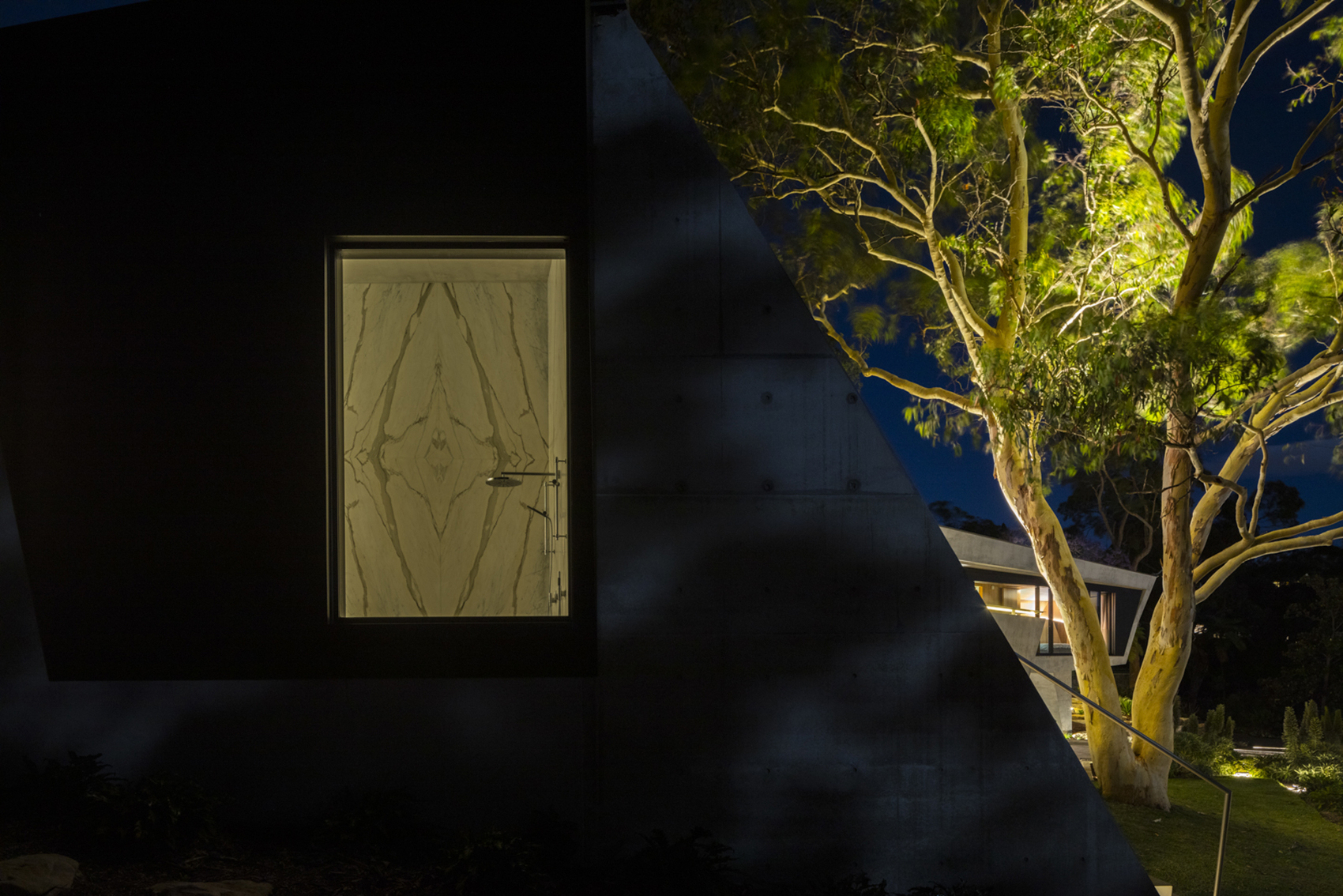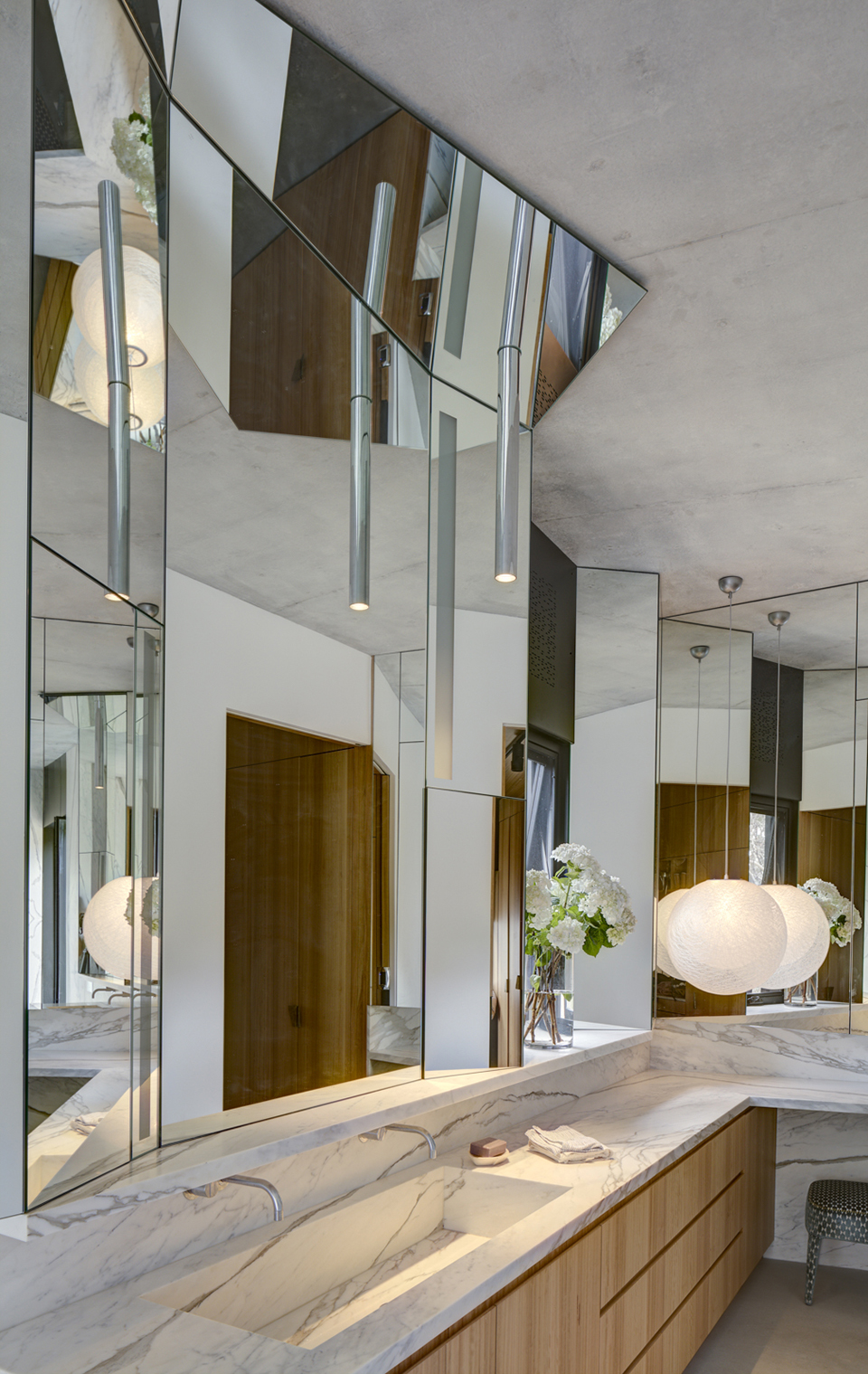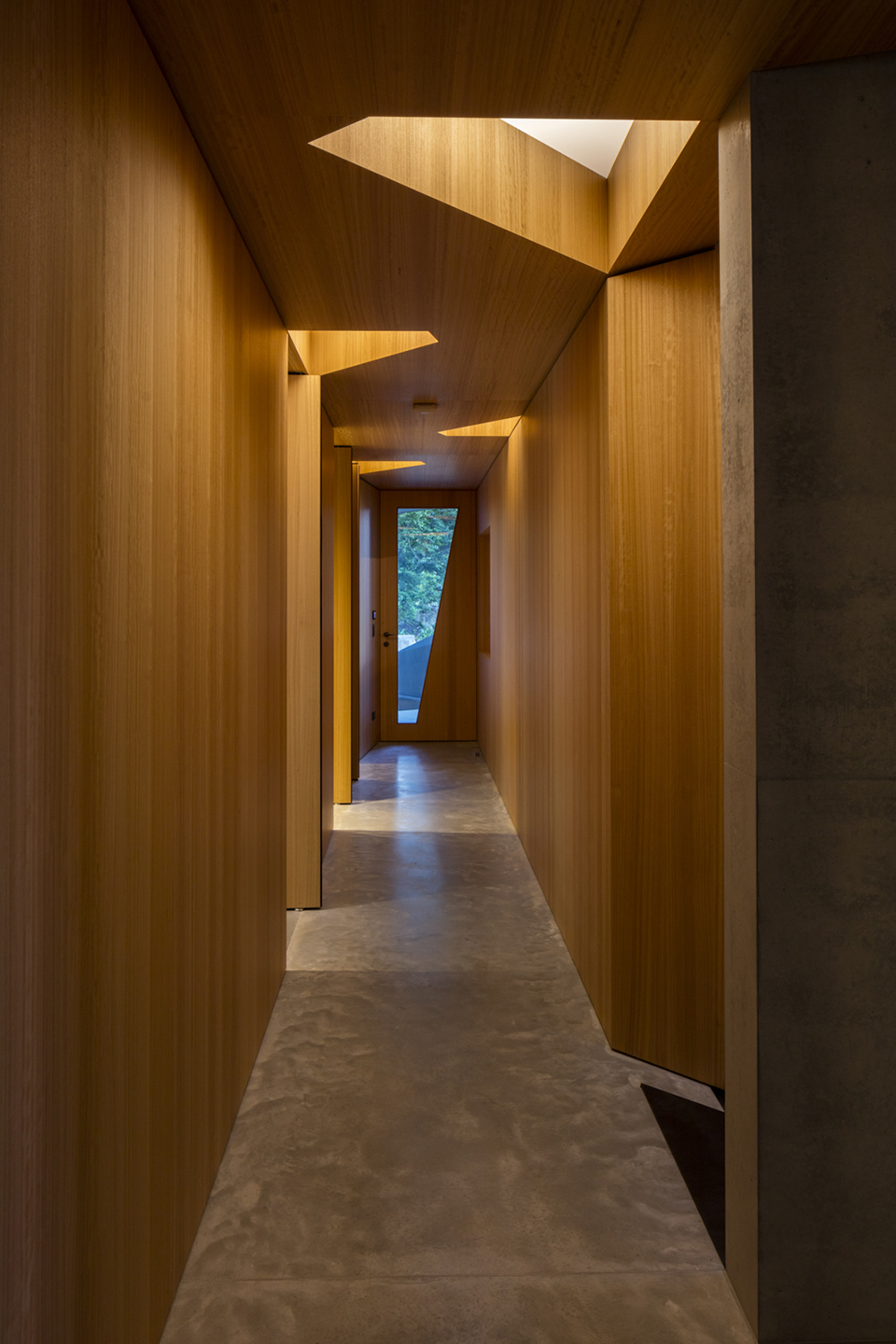在上个世纪,悉尼独栋住宅的历史将人们同景观的关系与住宅设计实验历史融合在一起。这两部分结合在一起,其中最令人难忘的是对内港周围陡峭而壮丽的景观的控制,以及这些房屋与所在基地及悉尼宜人气候的关系所带来的居住模式。
The history of the single-family house in Sydney during the last century is one that fuses an evolving approach to our relationship with the landscape with a history of experimentation in residential house design. These two strands have come together most memorably in the occupation of the steep and often spectacular landscapes around the inner harbour and the modes of habitation made possible in the way these houses relate to their site and Sydney’s benign climate.
▼项目鸟瞰,aerial view of the project ©Brett Boardman
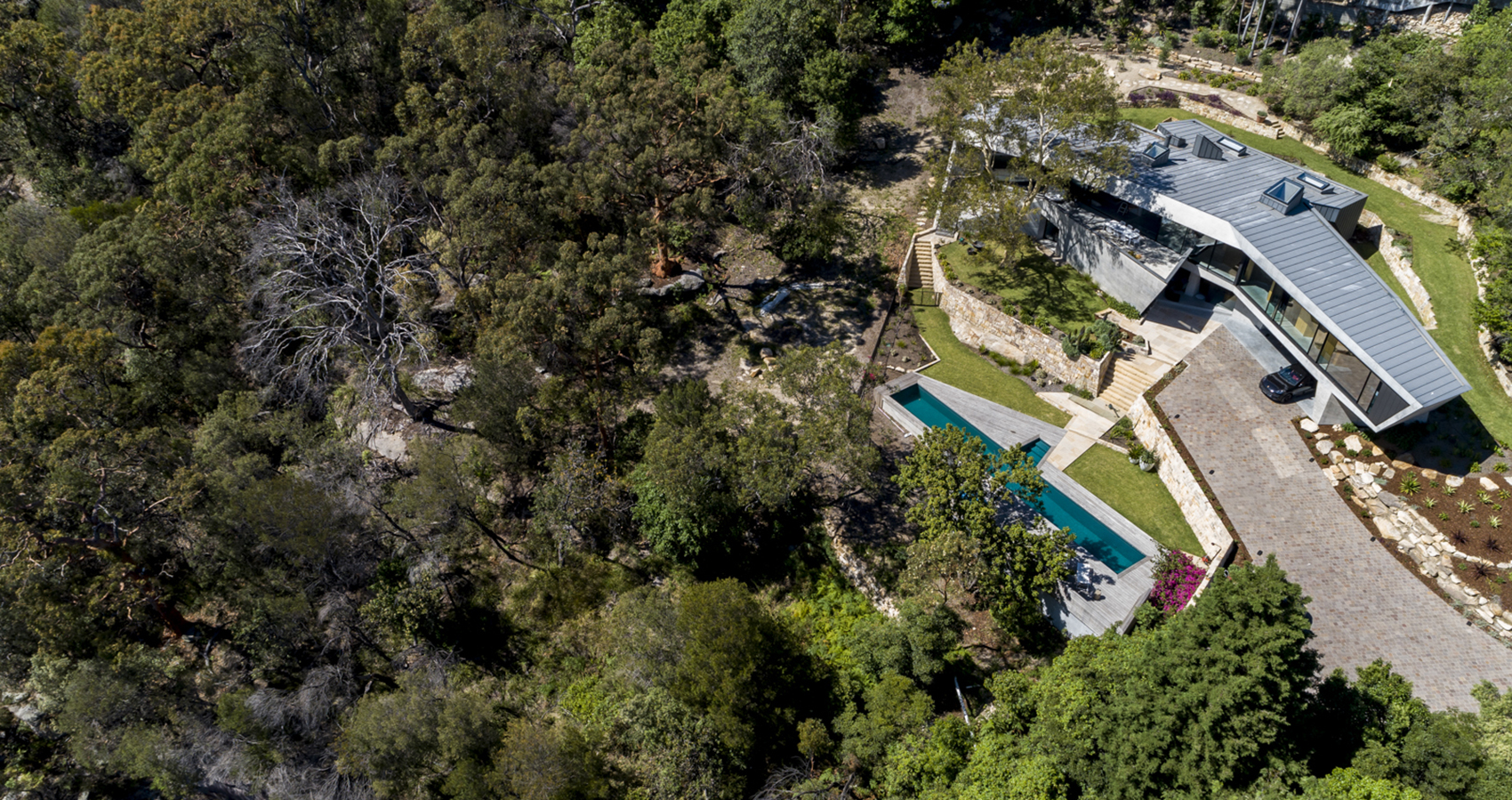
▼建筑外观,external view of the building ©Brett Boardman
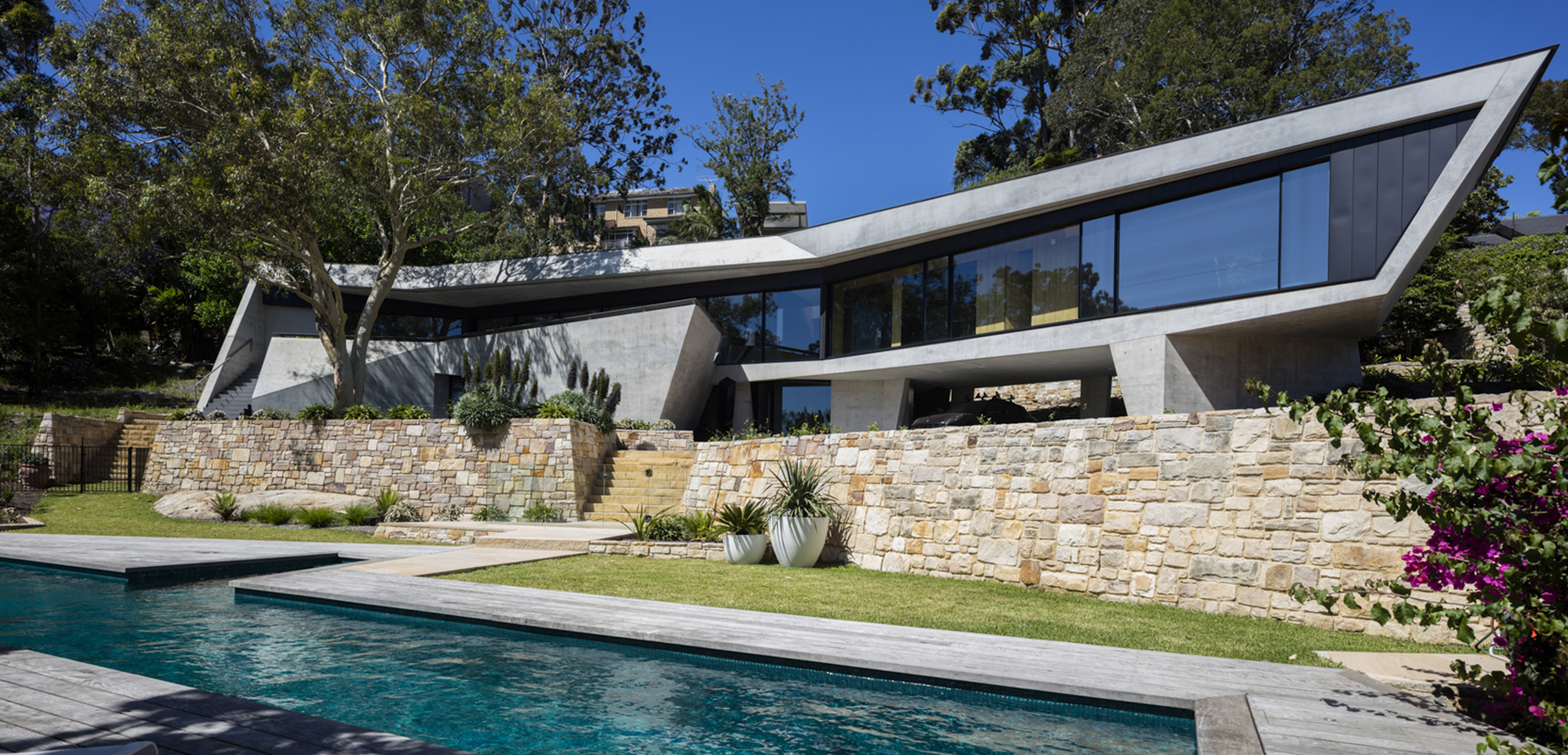
该项目位于悉尼代表性的环境之中——城堡湾,陡峭峡谷间的支流流经杯果木属灌木丛到达港口,从巨大峭壁到基岩纹路,砂岩地质遍及各处且形式多样。这些地形构造为设计提供了信息,不规则几何形状的混凝土外壳环绕地面上的岩石轮廓,创造出不规则的外观,既新颖又可以说是挖掘中“出土”的奇怪物体。无论是哪种形容,混凝土元素皆与基地的几何形状相呼应,同时形成建筑“峭壁”,为居住提供平台。混凝土“峭壁”顶部覆以连续的锌膜,在房屋后部折叠成口袋形状,以容纳私人房间。混凝土和锌这两种材料都会随着时间推移而老化,再次从“新的”外观转变为“先前存在的”外观。
This project is sited in one of these classic Sydney contexts, Castle Cove, where steep ravines contain tributaries that flow through angophora bushland down to the harbour. The sandstone geology is omnipresent and takes many forms, from mighty escarpments to minor ripples in the bedrock. These landscape tectonics inform the design, where a concrete shell of irregular geometry steps around outcrops and contours, creating an indeterminate form that is distinctively new but also could equally be a strange object ‘unearthed’ in excavation. Either way, the concrete element reverberates with the site geometry while forming a built escarpment that provides a plateau for habitation. The concrete escarpment is roofed in a continuous zinc membrane that folds over to form a smaller pocket to the rear containing private rooms. Both materials will patinate over time, moving again from a “new” to “pre-existing” form.
▼建筑后部-不规则几何形状的混凝土外壳,rear of the building – a concrete shell of irregular geometry ©Brett Boardman
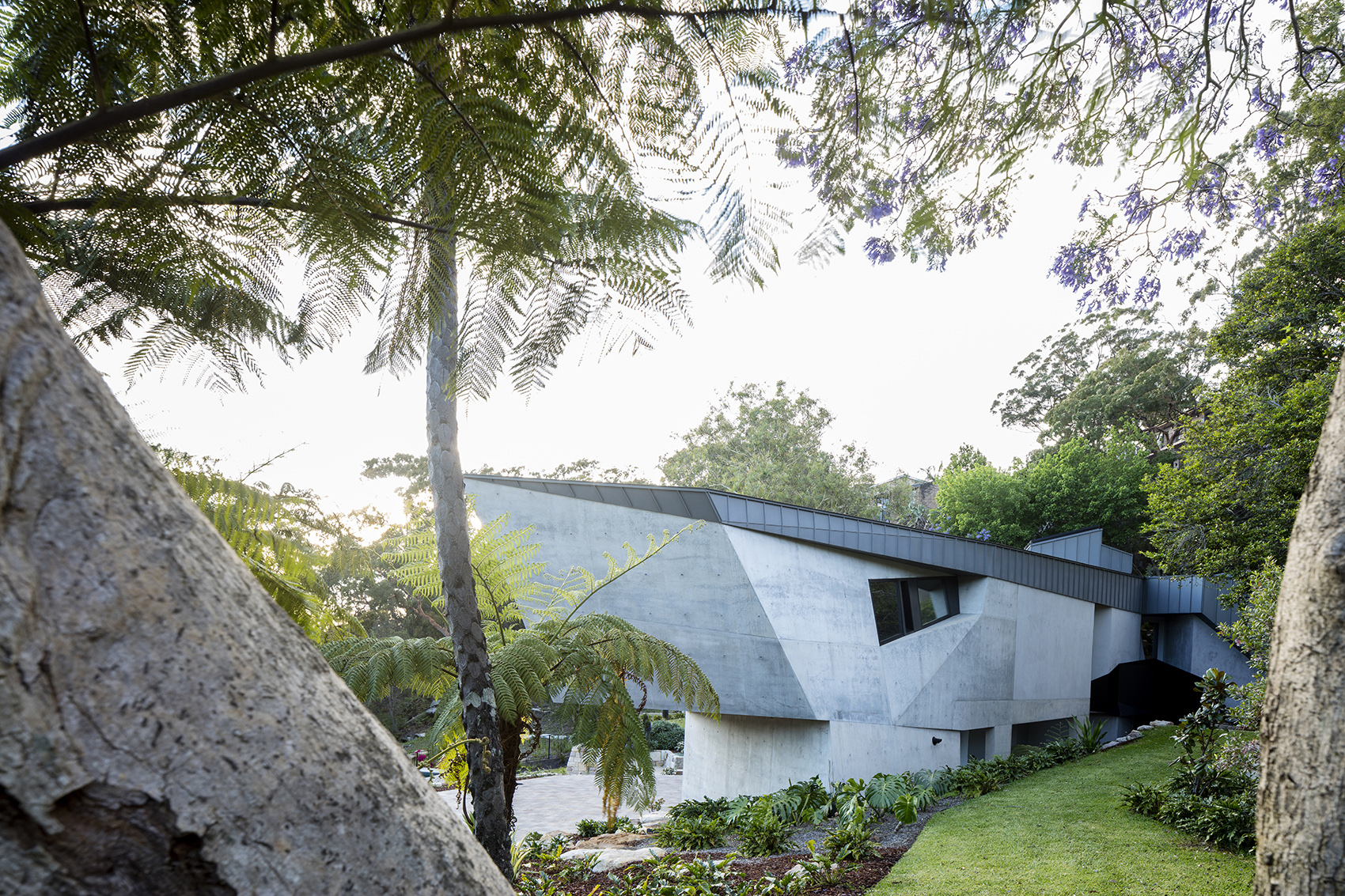
▼建筑前部-混凝土“峭壁”,front of the building- a concrete “escarpment” ©Brett Boardman
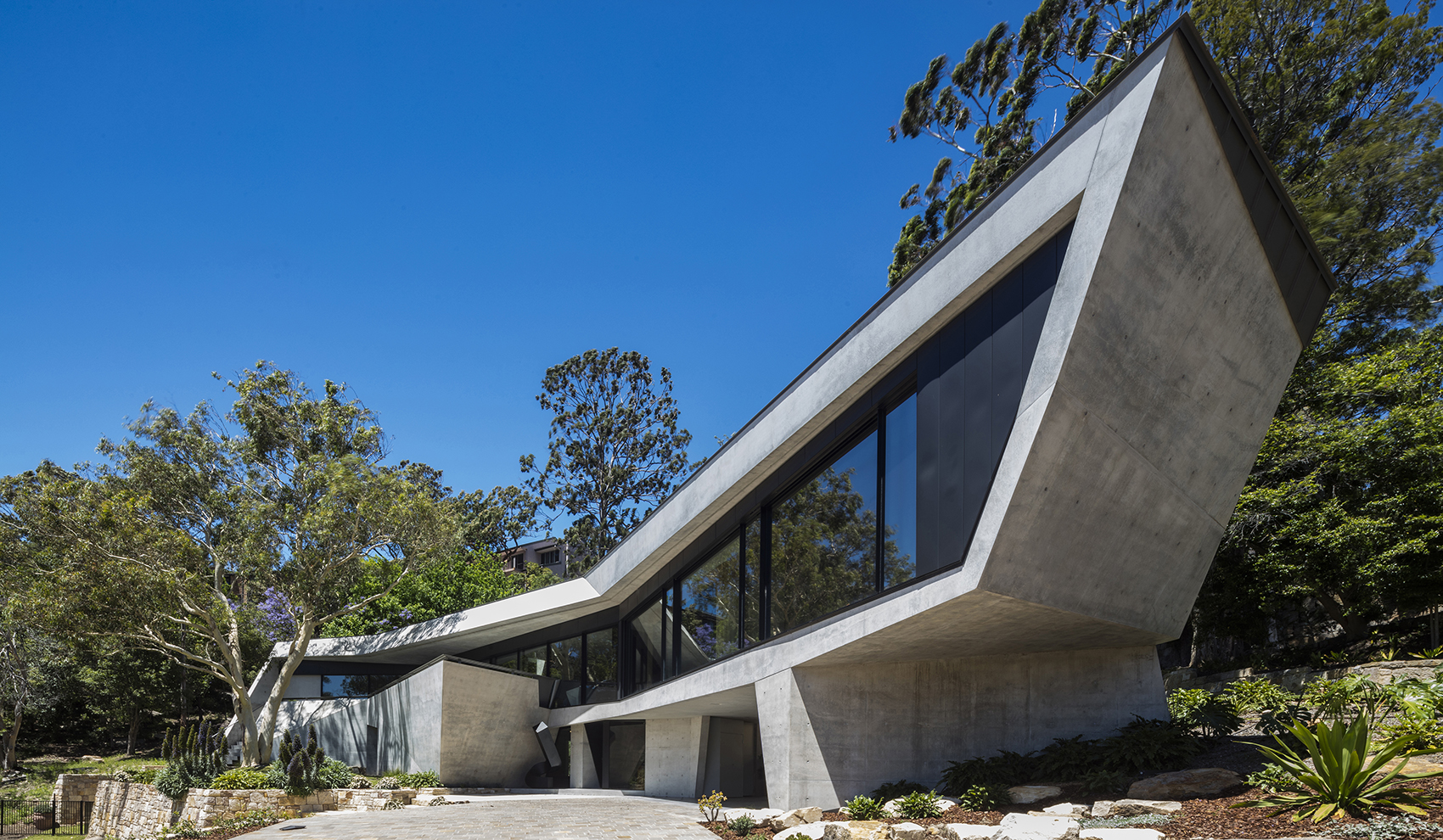
▼正立面,front facade ©Brett Boardman
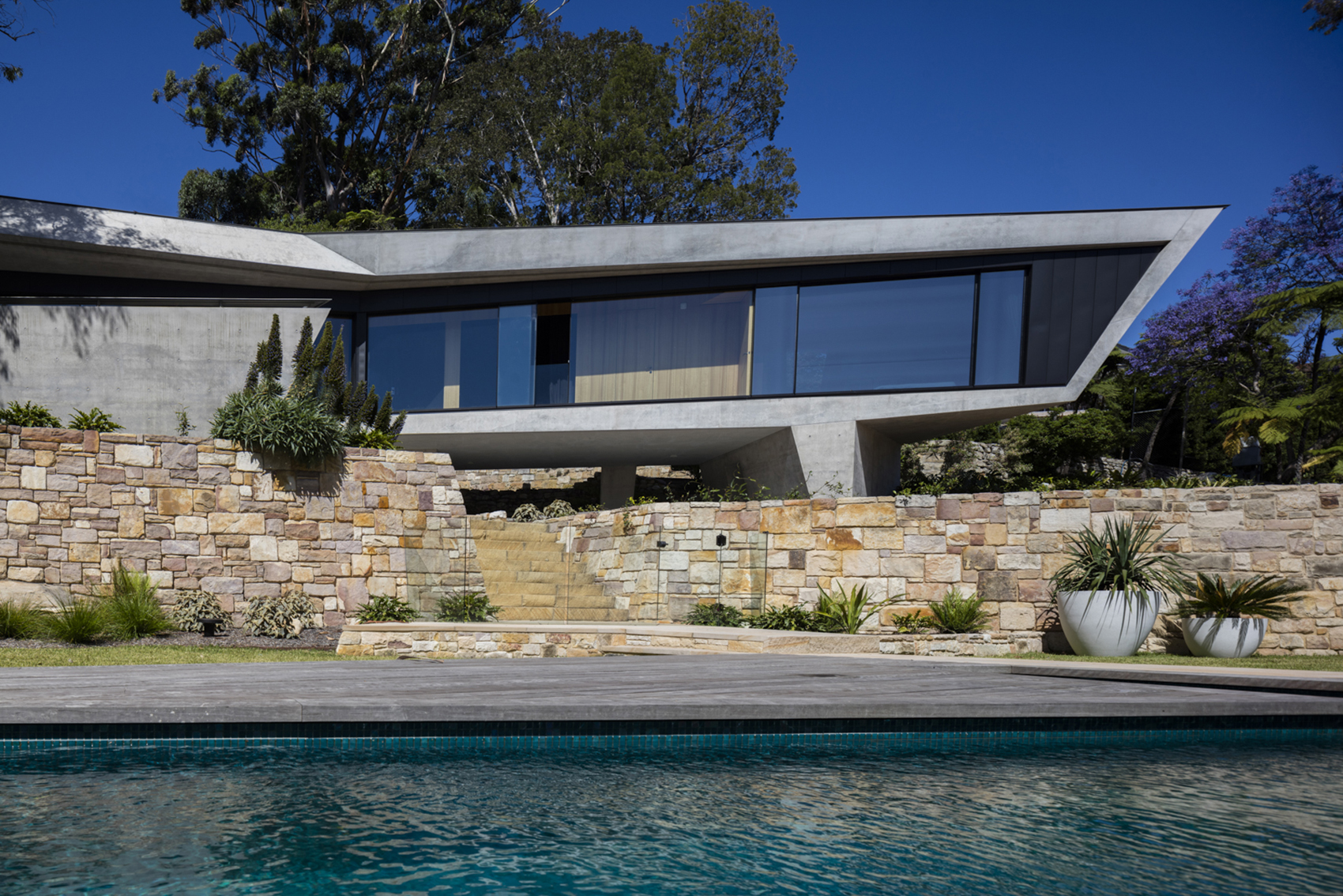
▼建筑一角,a corner of the building ©Brett Boardman
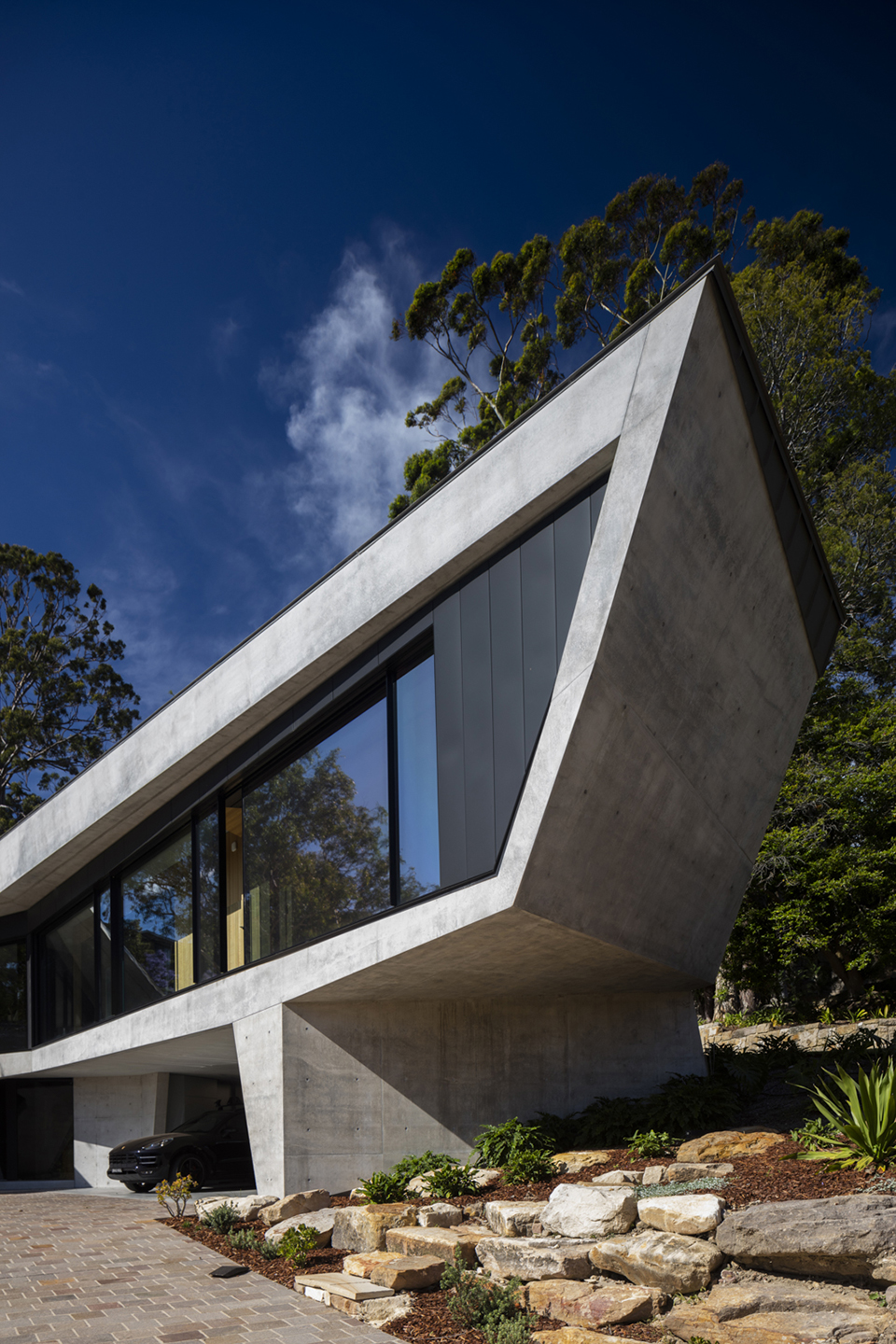
▼外观细部,detail ©Brett Boardman

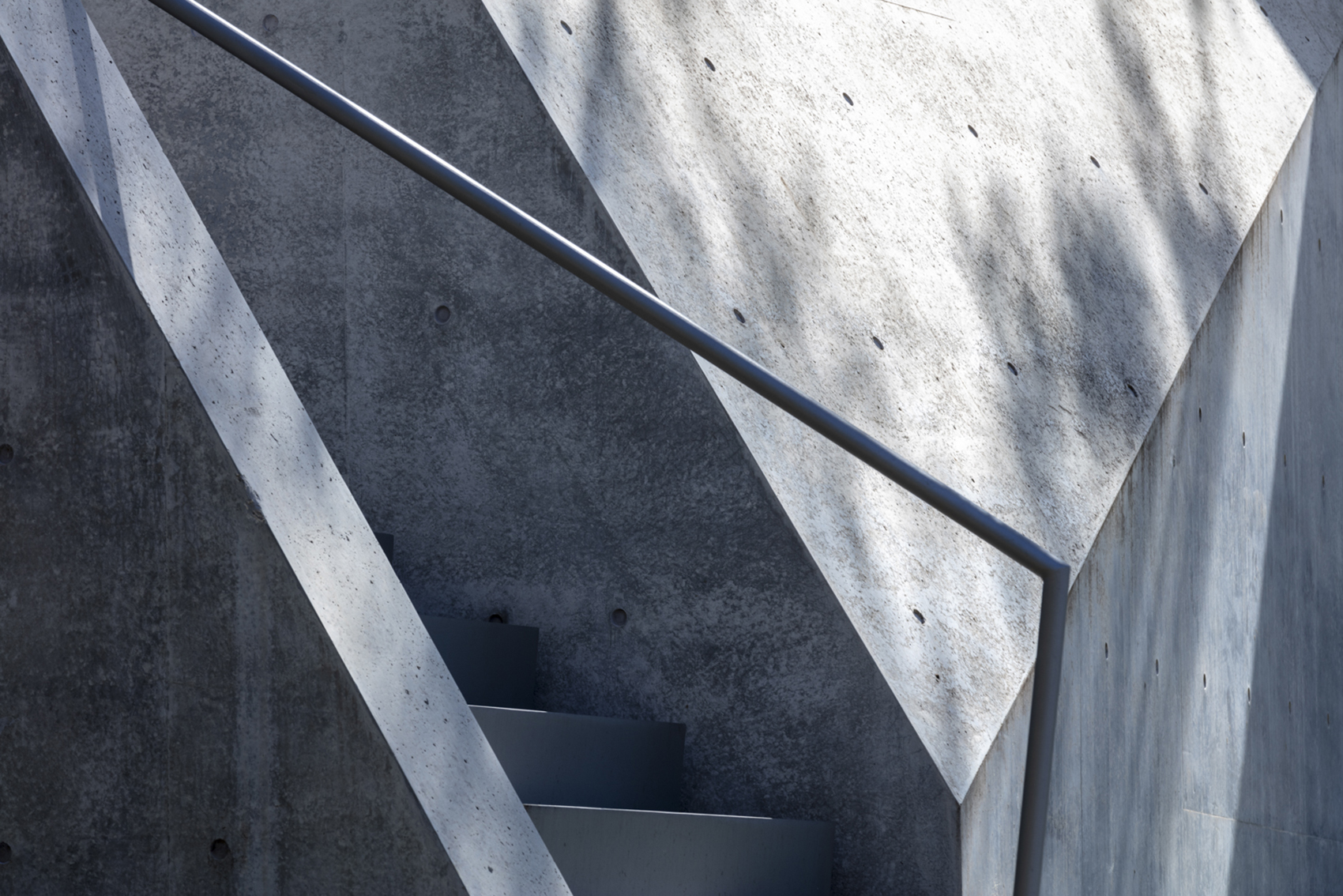
与外观对应的室内空间,通过一系列精细的木材赋予混凝土景观以灵魂和魅力,让人想起约翰·洛特纳(John Lautner)等人设计的加州世纪中叶住宅。由此产生的室内空间将居者与景观的不朽与绮丽联系起来,但仍然提供了日常生活所需要的私密时刻。室内空间还置入钢材、黄铜和镜面装饰,它们以内饰、长椅、窗户和天窗为基础,如同根据实际需求出发的配置。每个配置的联系点是混凝土容器的逐渐蔓延,包括物理上的(在裂缝和口袋处增加其孔隙度)和感知上的(通过镜面、贯穿所有楼层的天窗、限制声音隐私的洞口),这些都有助于扩大建筑在感官上的规模。在任何情况下,这些配置都是为了强化居者和景观之间的关系,而这种关系是由混凝土外观直接建立的。
The infrastructural nature of this primary gesture has in its counterpoint the means of occupying the house through a series of crafted timber linings that enable the occupation of this concrete landscape with a spirit and glamour reminiscent of California’s mid-century houses by John Lautner and others. The resulting interior spaces connect inhabitants with the monumental and wonderous nature of the landscape yet still provide intimate moments for occupation that are so necessary for everyday life. These linings are further embellished with a number of steel, brass and mirror inserts that are like devices or instruments that start in the practical requirements of occupation, given their basis in linings, benches, windows and skylights. The common thread through each instrument is the further diffusion of the concrete container both physically (in fissures and pockets that increase its porosity) and perceptually (through mirrors, skylights passing through all levels, openings that limit acoustic privacy) that serve to mentally expand the scale of the building. In every case, the instruments serve to intensify the relation between the occupants and landscape so directly established by the primary concrete form.
▼入口玄关,entrance porch ©Brett Boardman
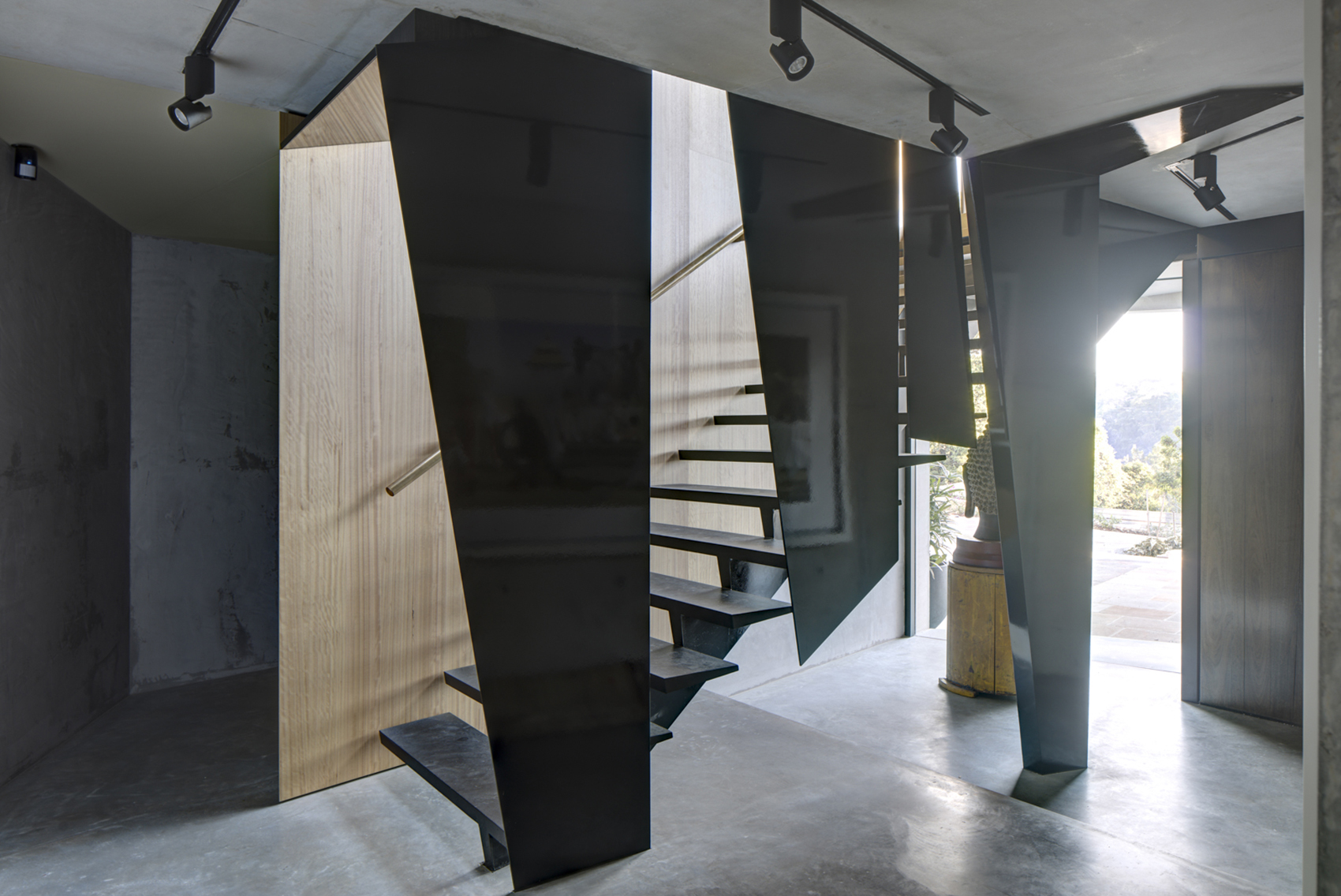
▼主要生活空间一览,main living space ©Brett Boardman
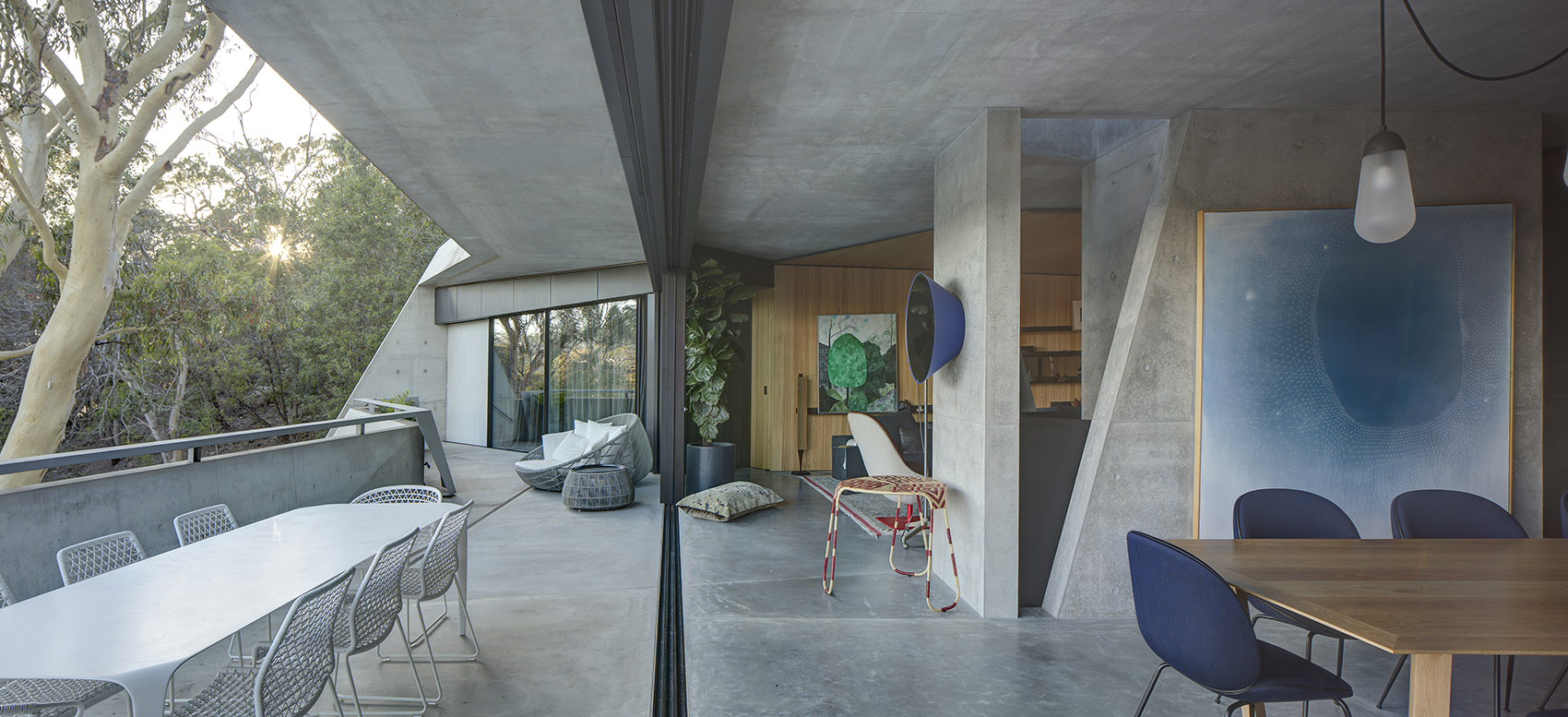
▼客厅,living room ©Brett Boardman
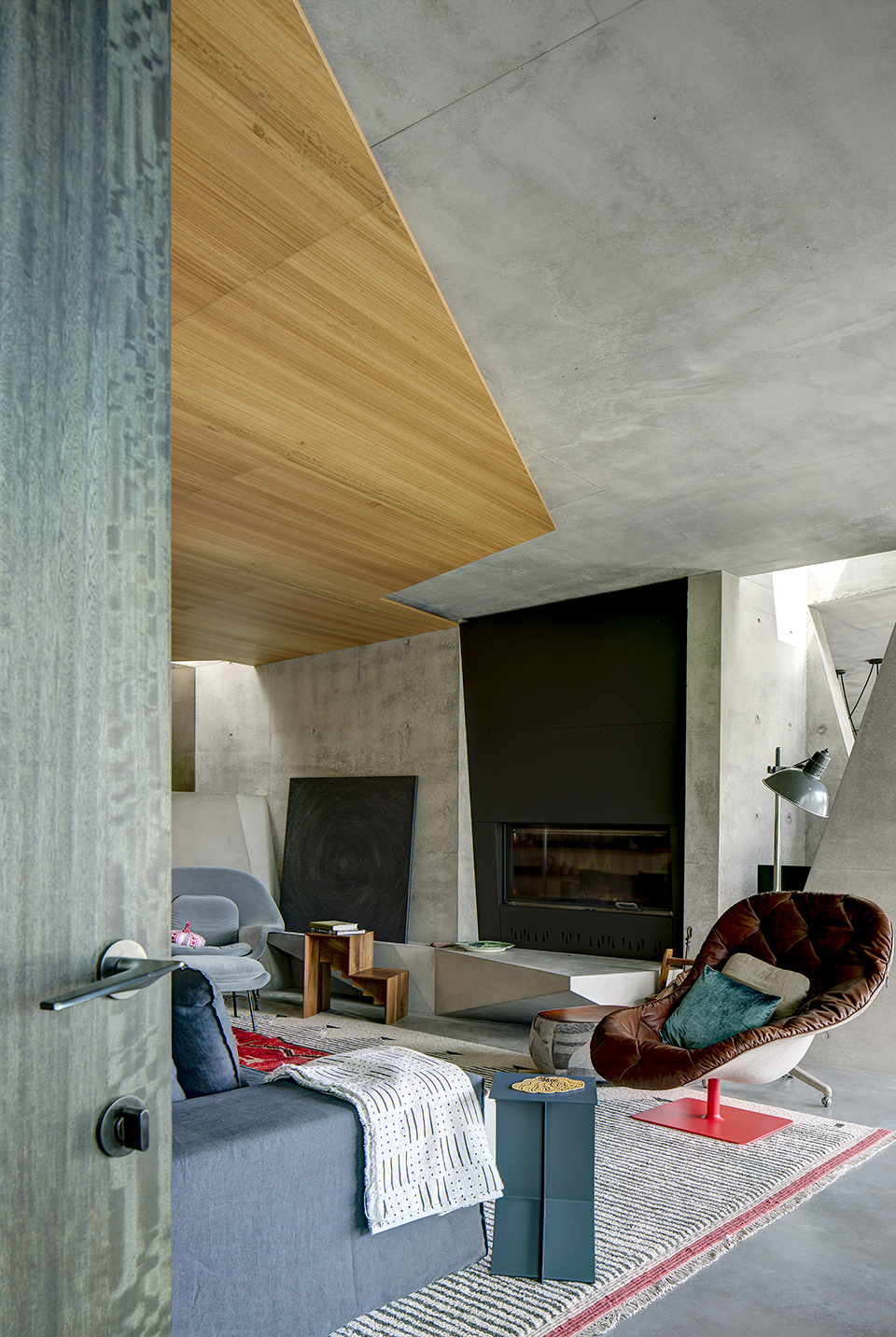
▼主卧,master bedroom ©Brett Boardman
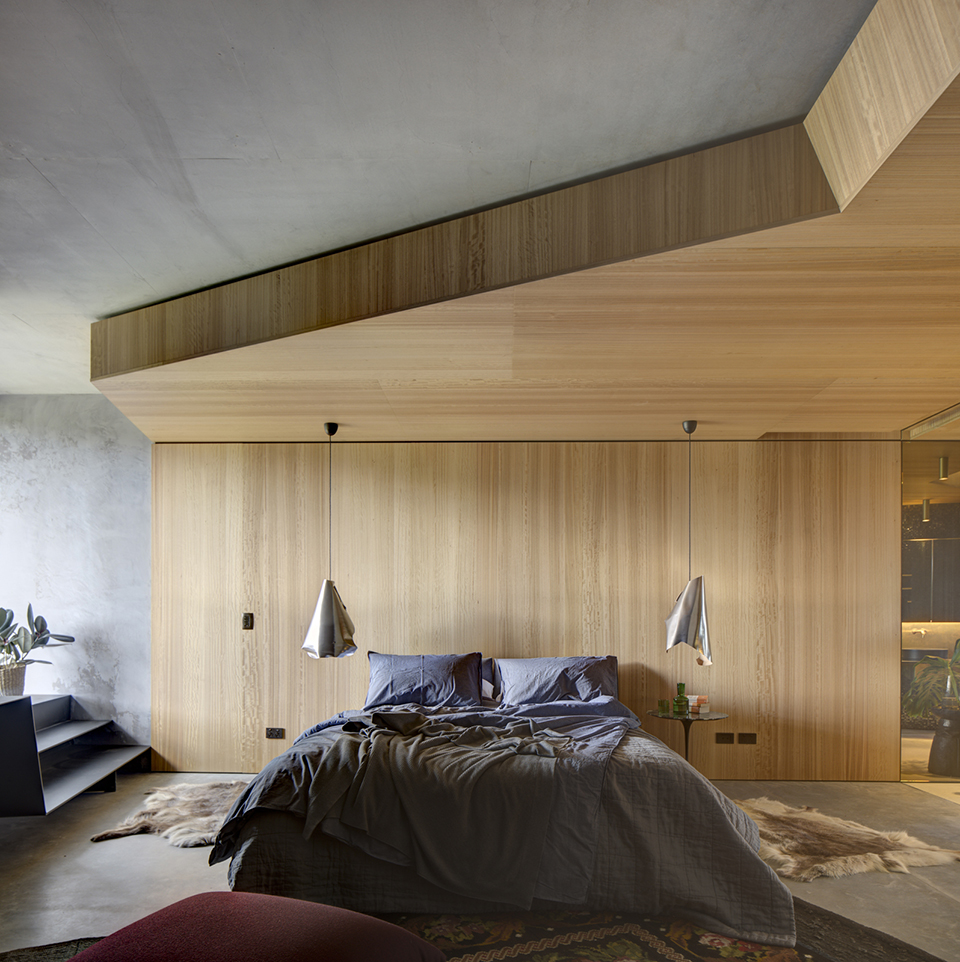
▼卧室一瞥,a glance to the bedroom ©Brett Boardman

▼卧室的天窗采光,skylight in the bedroom ©Brett Boardman
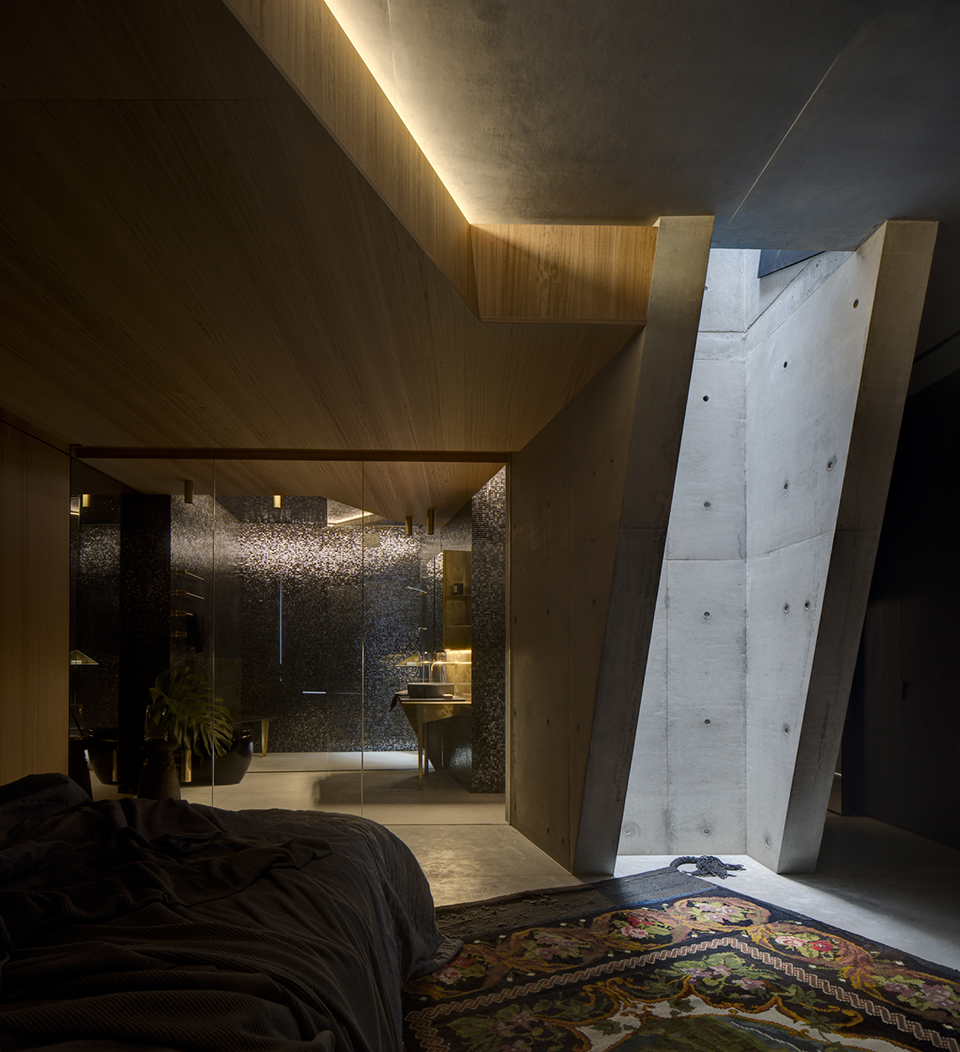
▼天窗采光,skylight ©Brett Boardman
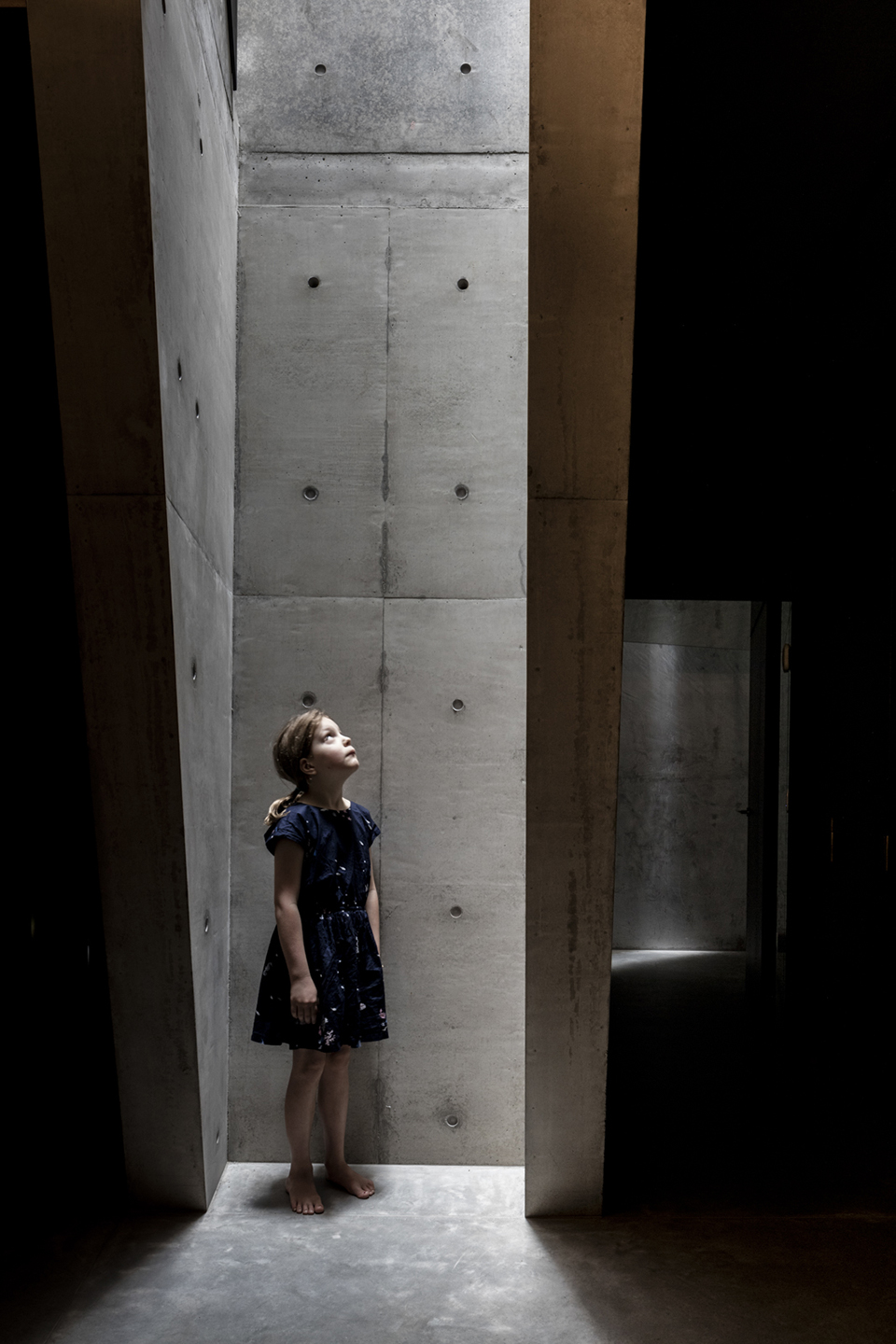
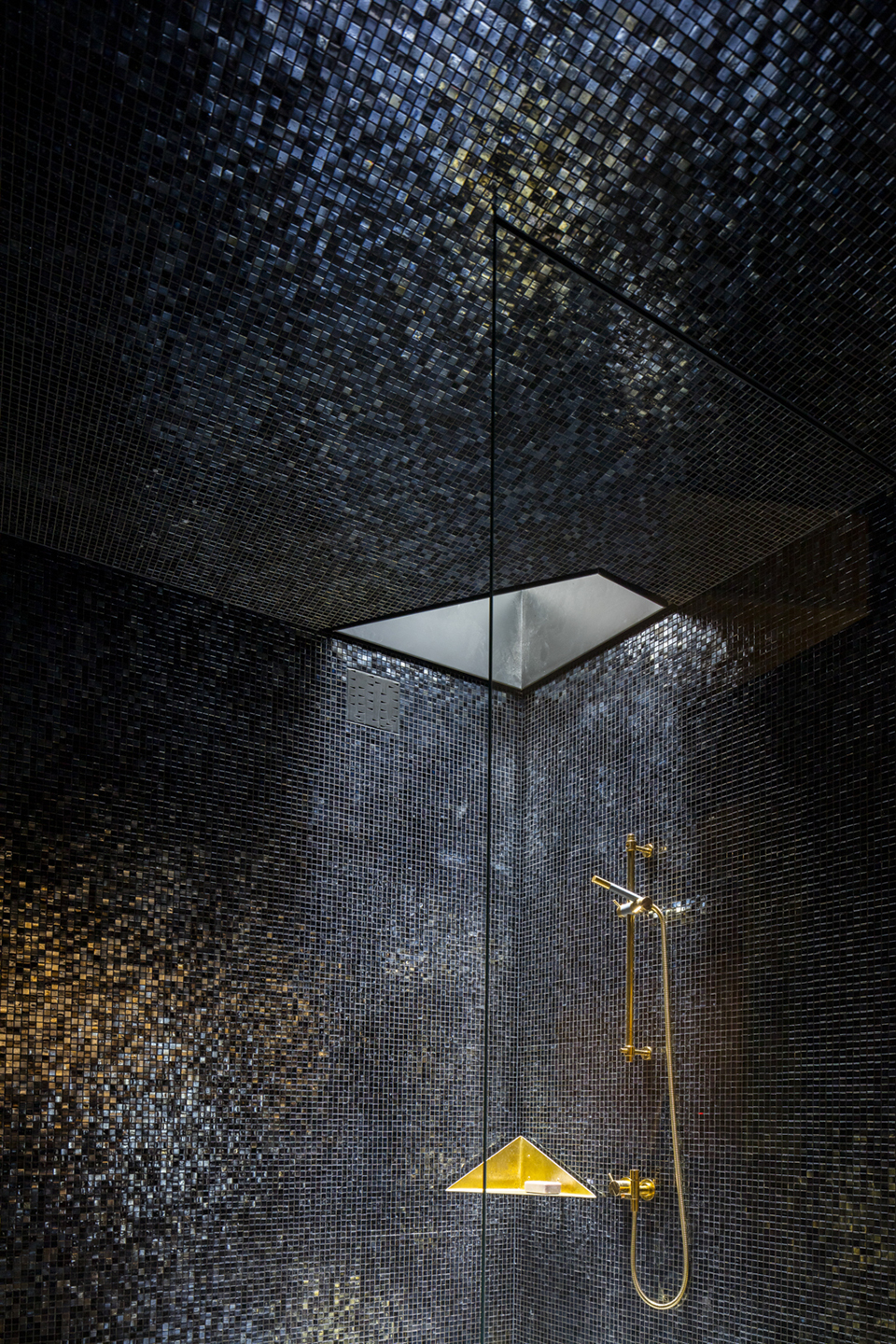
▼天窗细节,skylight detail ©Brett Boardman

▼材质细节,material detail ©Brett Boardman


这种与场所的紧密联系也促使房屋采用被动策略并与结构形式紧密相连。地下室作为冷源,通过地板通风口和向北倾斜的可调节天窗,使冷空气不断地通过主要居住空间,以吸收热量并促进对流过程。结合交叉通风、宽敞的悬挑、热质量、内外均设置百叶的双层玻璃窗以及循环地板加热系统,这些被动策略为居者创造了稳定的热环境,几乎不需要主动耗电。
This strong connection to place has also led to passive house strategies embedded in and intertwined through the form of the structure. The basement acts as a cold sink that allows for cool air to be constantly drawn through the main living spaces via floor vents and operable skylights purposely tilted north to draw heat and assist in the convection process. Combined with cross ventilation, generous overhangs, thermal mass, double glazing with internal and external blinds and a hydronic underfloor heating system these passive strategies have produced a thermally stable environment for the occupants that requires little active power consumption.
▼泳池夜景,swimming pool by night ©Brett Boardman
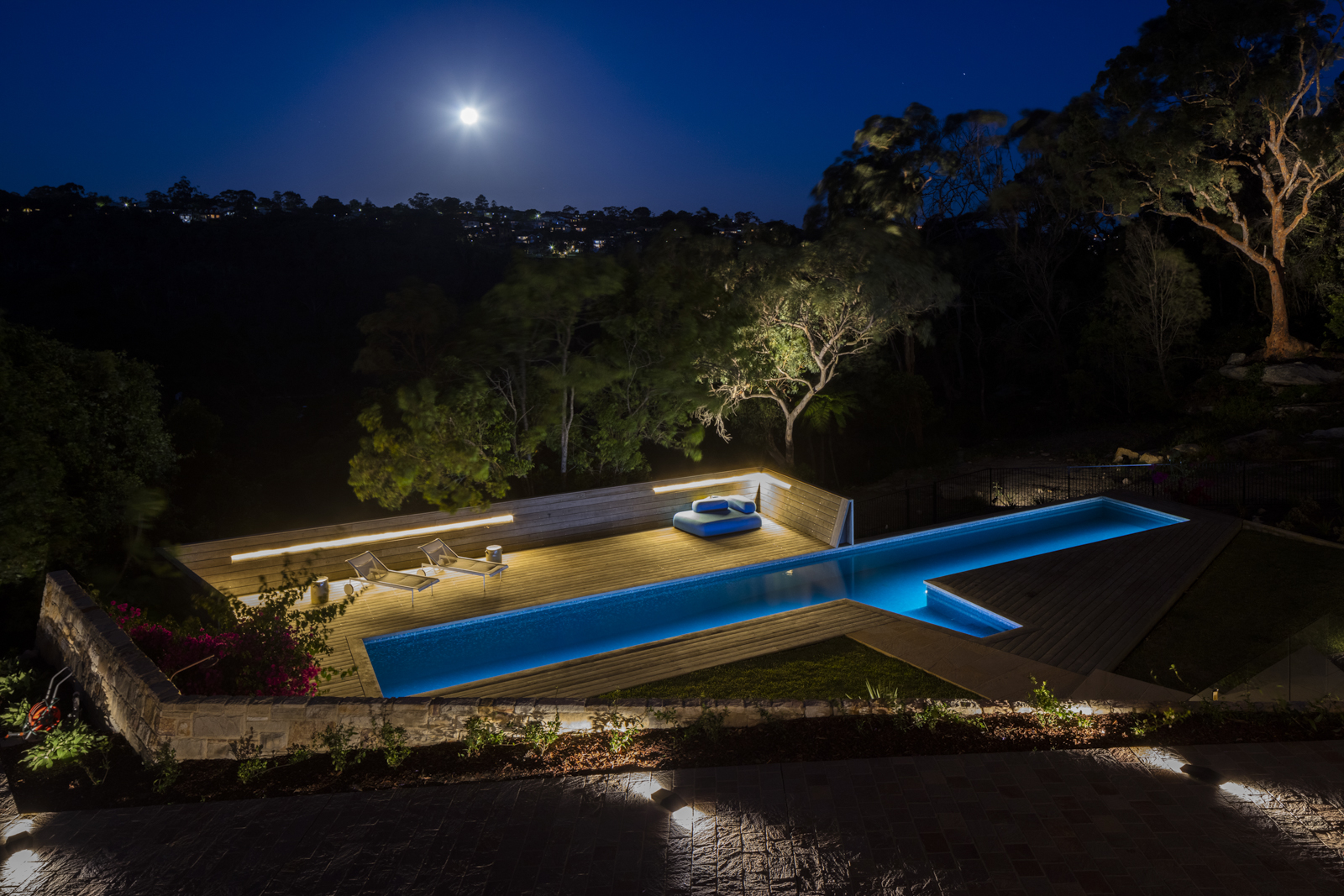
▼外观夜景,external view by night ©Brett Boardman
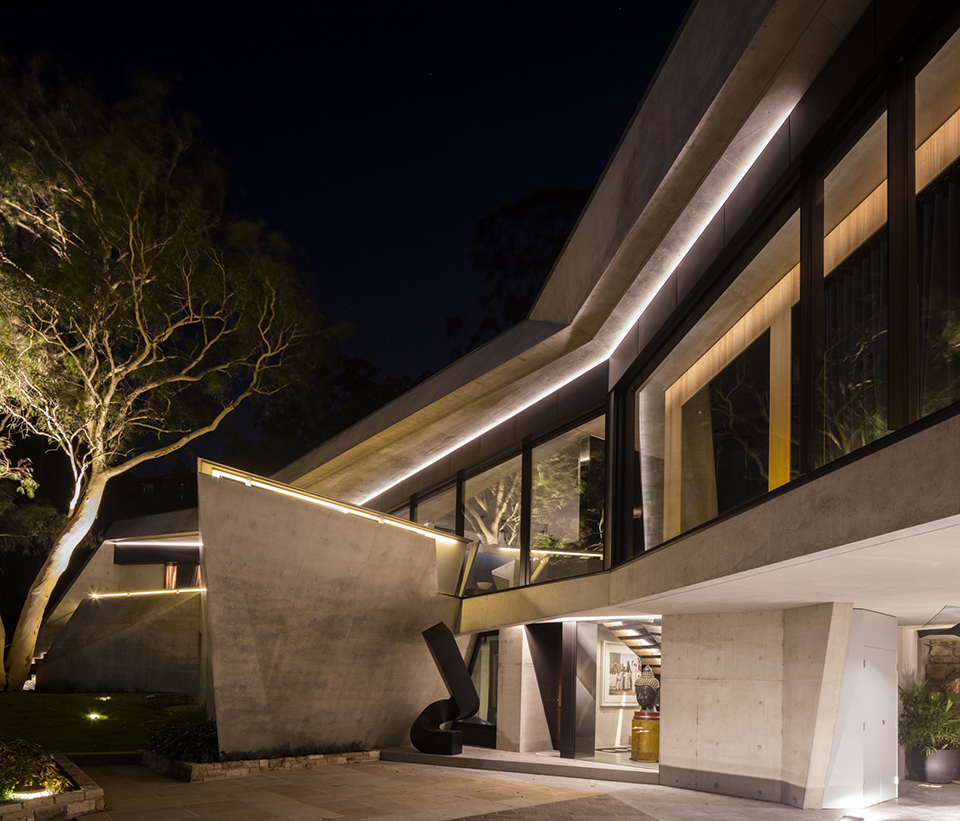
▼入口阶梯,entrance stairs ©Brett Boardman
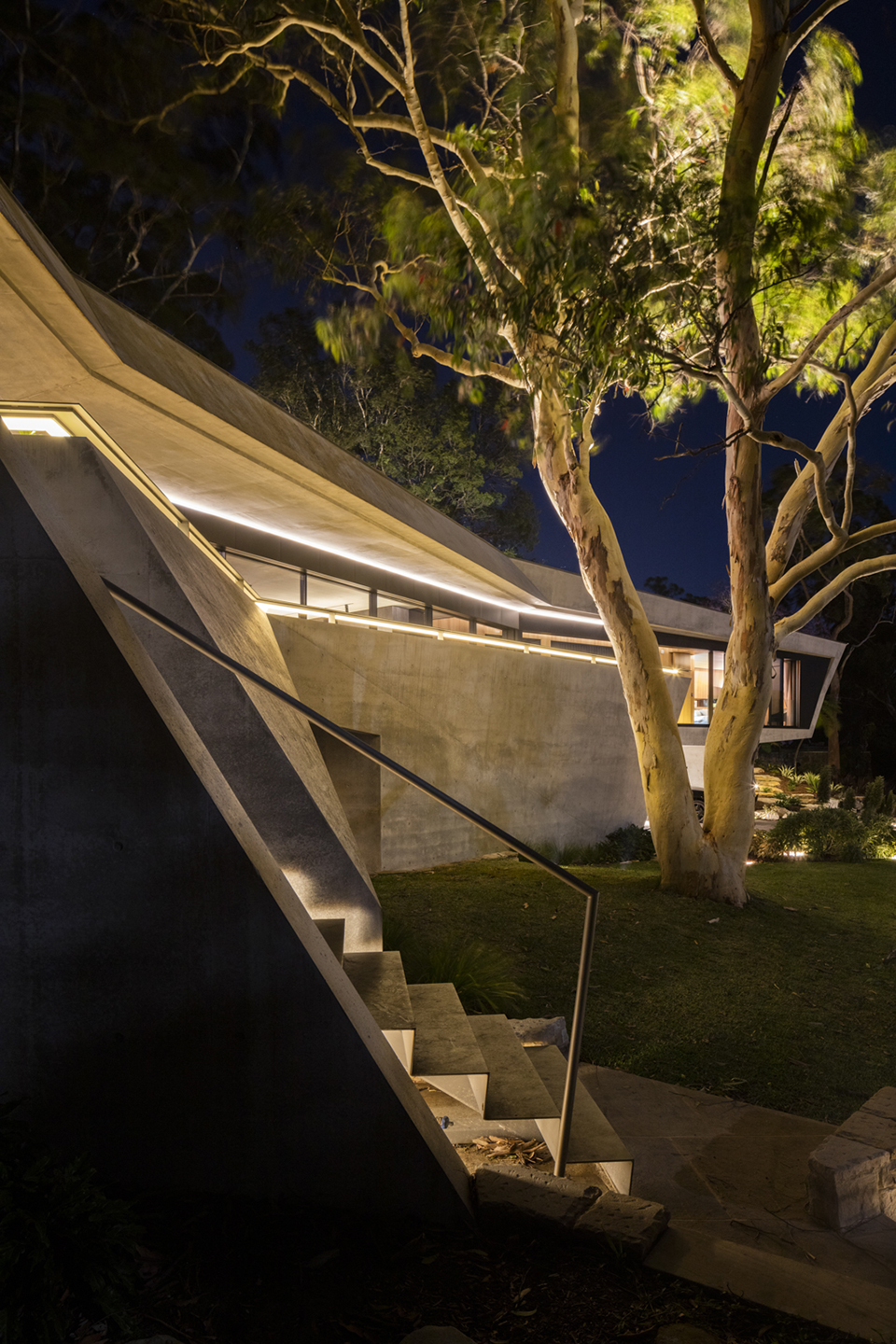
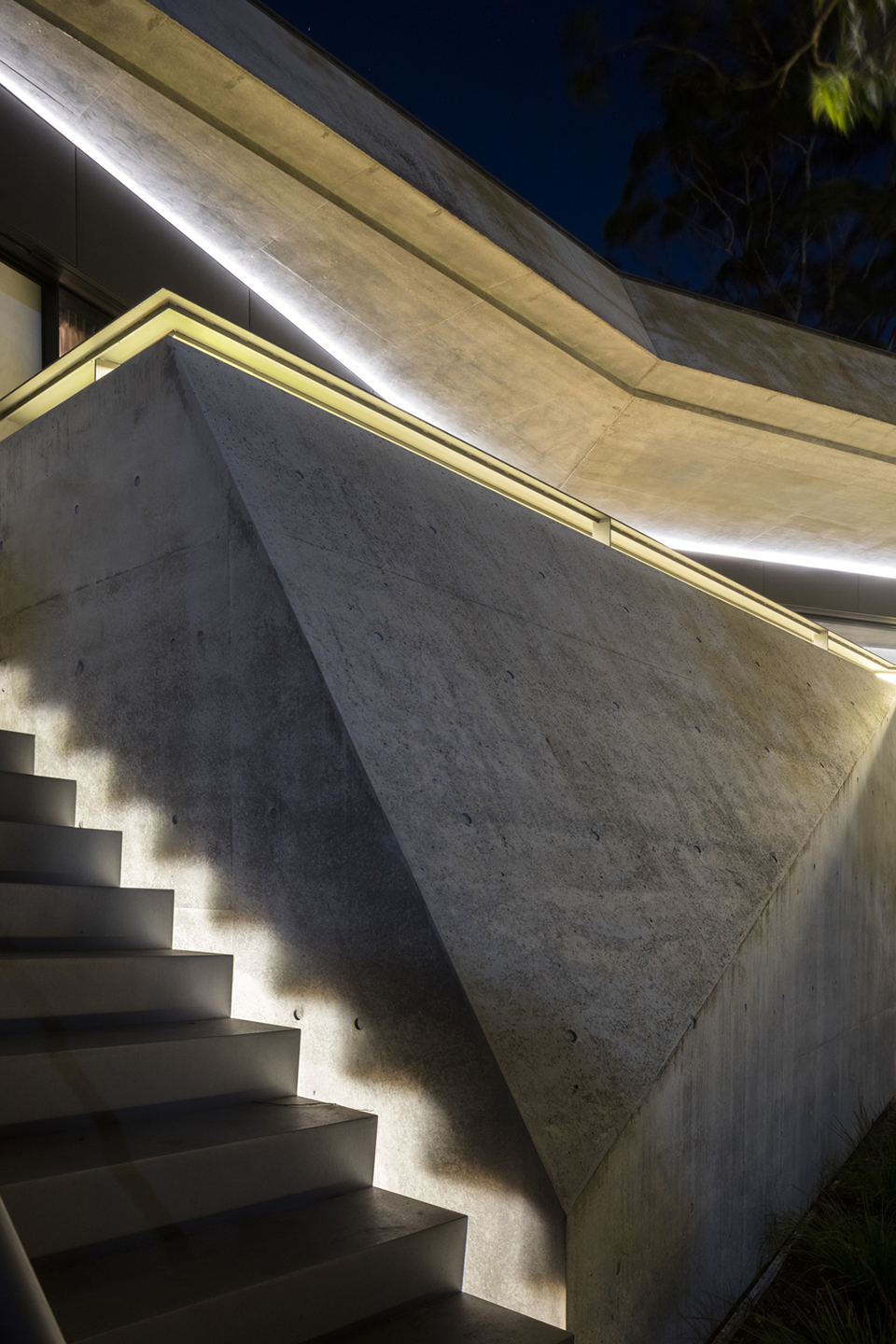
Interiors: TERROIR in collaboration with Pascale Gomes-McNabb Design Interior Styling: Pascale Gomes-McNabb Design Lighting Design: TERROIR in collaboration with Pascale Gomes-McNabb Design ESD Advice and Thermal Modelling: Beckham Price – SBE (Sustainable Built Environments) Structural Engineer: Kevin Mongey Simpson Design Associates (SDA Structures) Hydraulic Engineer Design: Andreas Heintz – Warren Smith and Partners Hydraulic Engineer Site: Michael Frost Builder Concrete Structure: Tony Olding Exterior and Interior finishing: Ed Callanan – Callanan Constructions Builder Concreter: GD Concrete Concrete Finishing: Stoneart Roofing and Soft metalwork: ARC Roofing Joinery: Rintoul Metalwork and Structural Steel: Salken Engineering Electrical: Steve Nee – CandSnee Plumbing: Innerwest Plumbing Windows: Vistrosca Sliding Windows and Pivot doors Skylights: Atlite Skylights Bushfire Curtains: Greene Fire Principal Certifying Authority: Anthony Protas Consulting Pty Ltd
▼项目更多图片
